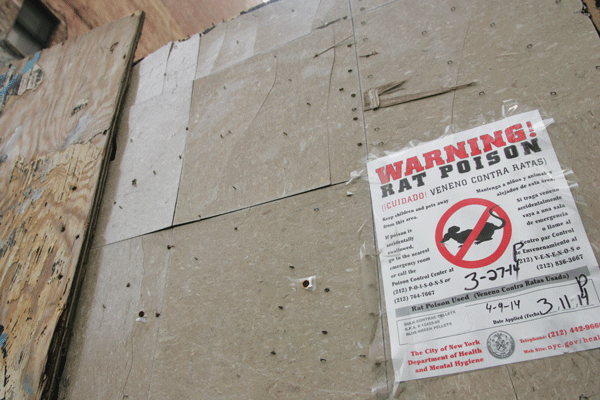
The front of the 403 Greenwich St. lot.
BY SAM SPOKONY | It’s been said many times before — earlier this year, last year, five years ago, ten years ago. And now it’s being said again.
Tribeca is full of rats — and since they don’t have to worry about rising condo prices, the critters are showing no signs of leaving their homes within nests burrowed in soil and sidewalks.
“I’ve walked along Greenwich St., from Beach down to Chambers, many times in response to complaints, and I can see that there’s clearly a rat problem in this neighborhood,” said Caroline Bragdon, a research scientist for the city’s Department of Health, during a “Rodent Academy” presentation at Community Board 1’s April 17 Quality of Life Committee meeting.
A rat problem — as if the locals still needed anyone to tell them that.
“Yeah, it was like a rat farm,” said Diane Lapson, a C.B. 1 member and president of Independence Plaza North’s tenants association, recalling a February walk along Greenwich St. that she attended alongside Bragdon and other officials and area residents, and which was undertaken specifically to gauge the problem.
“I just want to stop them from eating my flowers,” said Anne Patterson, a member of Friends of Bogardus Garden, which cares for the green space along W. Broadway, between Chambers and Reade Sts.
But while there are certainly some hot spots in the community — generally areas around restaurants and construction sites, as well as certain open spaces like Bogardus — Tribeca’s march of the rodents can’t be stopped just by dealing with individual property owners, or loading up troublesome lots with poisoned bait, according to the Health Dept. Instead, it’ll take a village, as the saying goes.
“It’s really reached the neighborhood level, where you have rats feeding in communal garbage cans along the street and plastic bags sitting outside buildings, whether they’re commercial or residential,” said Bragdon. “So at this point it becomes a community issue, and it’s one that won’t be solved unless you have numerous people who live and work here participating in a rat control plan.”
And a key part of rat control, she stressed, is garbage management.
That means making sure plastic garbage bags aren’t overflowing or leaking when they’re taken outside — and specifically for residents and building workers, a potentially helpful approach involves taking out the trash in the early morning, rather than at night, Bragdon explained, giving rats much less of an opportunity to scrounge through the piles overnight before city sanitation workers make their morning pickup rounds.
Speaking more broadly, the Health Dept. rep also pointed out that standard city trash cans — those of the steel mesh variety, often found on street corners — are often a haven for rats, who easily drag away food through the openings in the steel wire or feast on inevitable leaks onto the sidewalk. Notably, Health Department studies have shown that neighborhoods with a business improvement district, or BID, are generally more protected against rodents because they invest money in solid steel trash cans, or, as with the Downtown Alliance — the major BID below Chambers St. — they even go as far as purchasing solar-powered trash compactors, which are fully sealed and keep the rats at bay.
But for now, of course, Tribecans will have to do the best with what they have. And Manhattan Borough President Gale Brewer, who stopped by the April 17 meeting, remained relatively optimistic about tackling the problem.
“We can get rid of the rats, but boy, it’s a collaborative effort,” said Brewer, who had a similar experience in her last job as an Upper West Side City Councilmember. She explained that one successful initiative involved bringing together numerous residential building superintendents to figure out shared problems and work jointly on things like garbage management. Another, she pointed out, involved focusing attention on certain “culprits” who neglected to deal with ongoing rodent infestations on their property.
One of those generally recognized culprits is the owner of a currently vacant lot at 403 Greenwich St., on which an eight-story luxury residential building is planned. The lot, which has remained empty since the demolition of its previous building last year, received a D.O.H. violation this year after officials found that it contained numerous nests, housing swarms of rodents that likely feed off garbage from neighboring restaurants including the adjacent Wolfgang’s Steakhouse (which has not faced any interior infestation or received any violations).
During the April 17 meeting, Bragdon said that the city has since treated the lot with bait — and billed the owner, 403 Greenwich Enterprises — but added that, based on what she’s seen recently, the owner still hasn’t done much to help the situation.
“After today I’ll make sure that we issue them another violation,” she said.
A representative of 403 Greenwich Enterprises said in an April 21 phone interview, that an exterminator visits the site monthly, but didn’t seem concerned about the ongoing attention from the Health Dept.
That’s likely because rat-related violations carry a relative miniscule fine. After $300 for a first offense, repeat incidents can only bump the fine up to a maximum of $2,000 — not worthy of much financial concern for a Tribeca developer.
But in any case, that 403 Greenwich St. lot may not remain vacant for much longer, even though Department of Buildings construction permits have yet to be filed.
The owner’s rep, who did not give his name, told Downtown Express that construction on the site will begin within the next two months.
Meanwhile, another rat hot spot identified by Bragdon is located inside one of the sidewalk planters along Greenwich St., at the corner of Franklin St. — just outside the Tribeca Deli, which is located alongside the I.P.N. residential development. She pointed out that the soil in the planter contains “several active burrows” that house the rodents.
A worker at the Tribeca Deli said he had never seen any rats outside, but he wasn’t interested in discussing the matter in much detail.
The deli is just a block away from Josephine, a restaurant at the corner of Greenwich and Harrison Sts. that was briefly shut down by D.O.H. in December due to, among other things, rats spotted in the kitchen.

















